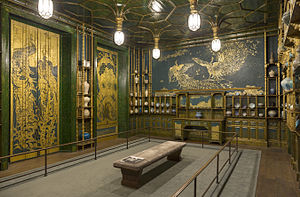Peacock Room
| Harmony in Blue and Gold: The Peacock Room | |
|---|---|
| Artist | James McNeill Whistler |
| Year | 1877 |
| Type | Room installation |
| Medium | Oil paint and gold leaf on canvas, leather, and wood |
| Dimensions | 421.6 cm × 613.4 cm × 1026.2 cm (166.0 in × 241.5 in × 404.0 in) |
| Location | Freer Gallery of Art, Washington, D.C. |
| 38°53′16.50″N 77°01′37.00″W / 38.8879167°N 77.0269444°W | |
| Accession | F1904-61 |
Harmony in Blue and Gold: The Peacock Room (better known as The Peacock Room) is James McNeill Whistler's masterpiece of interior decorative mural art, located in the Freer Gallery of Art in Washington, DC. He painted the paneled room in a rich and unified palette of brilliant blue-greens with over-glazing and metallic gold leaf. Painted between 1876–77, it now is considered one of the greatest surviving aesthetic interiors, and best examples of the Anglo-Japanese style.
The Peacock Room was originally designed as a dining room in the townhouse located at 49 Prince's Gate in the neighbourhood of Kensington in London, and owned by the British shipping magnate Frederick Richards Leyland. Leyland engaged the British architect Richard Norman Shaw to remodel and redecorate his home. Shaw entrusted the remodelling of the dining room to Thomas Jeckyll, another British architect experienced in the Anglo-Japanese style. Jeckyll conceived the dining room as a Porsellanzimmer (porcelain room).
He covered the walls with 6th-century wall hangings of Cuir de Cordoue that had been originally brought to England as part of the dowry of Catherine of Aragon. They were painted with her heraldic device, the open pomegranate, and a series of red roses, Tudor roses, to symbolise her union with Henry VIII. They had hung on the walls of a Tudor style house in Norfolk for centuries, before they were bought by Leyland for £1,000. Against these walls, Jekyll constructed an intricate lattice framework of engraved spindled walnut shelves that held Leyland’s collection of Chinese blue and white porcelain, mostly from the Kangxi era of the Qing dynasty.
...
Wikipedia


